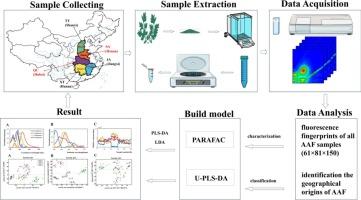三维荧光结合化学计量学快速判别艾叶来源。
IF 4.6
2区 化学
Q1 SPECTROSCOPY
Spectrochimica Acta Part A: Molecular and Biomolecular Spectroscopy
Pub Date : 2025-09-11
DOI:10.1016/j.saa.2025.126926
引用次数: 0
摘要
艾叶(Artemisia Argyi Folium, AAF)是传统医学中重要的妇科药物,具有温经止血、散寒止痛的功效。常用于治疗月经紊乱、子宫寒性不孕症等症状。AAF的治疗效果和质量受其地理来源的显著影响,导致很大的区域差异。本研究旨在将三维荧光技术与化学计量学相结合,建立一种准确、高效的鉴别黄芪产地的方法。首先,采用PARAFAC算法对AAF样品的荧光指纹光谱进行综合分析。在五个不同来源的AAF中观察到的荧光模式表现出可比的发光团性质;然而,它们的强度各不相同。发光特性的存在可能归因于AAF的化学成分,特别是黄酮类和多酚类。为了根据地理来源对AAF样本进行分类,使用了几种建模方法:U-PLS-DA、PLS-DA和LDA。值得注意的是,U-PLS-DA模型表现出优异的性能,在训练集和独立测试集上都实现了100%的识别准确率,从而能够在五个地理位置之间进行精确区分。本研究不仅为艾叶的产地鉴定提供了可靠的方法,保证了艾叶的质量和功效,而且为其他中药材的溯源研究开辟了新的方向,具有广阔的应用前景和深远的影响。本文章由计算机程序翻译,如有差异,请以英文原文为准。

Rapid discrimination of Artemisia Argyi Folium origin using three-dimensional fluorescence combined with Chemometrics
Artemisia Argyi Folium (AAF), as a prominent gynecological medicine in traditional medicine practice, is renowned for its effects in warming meridians to stop bleeding, dissipating cold and alleviating pain. It is frequently used to treat symptoms such as menstrual disorders and uterine cold infertility. The therapeutic efficacy and quality of AAF are significantly influenced by its geographical origin, leading to substantial regional variations. This study aims to establish an accurate and efficient method for discriminating the geographical origin of AAF by combining three-dimensional fluorescence technology with chemometrics. Initially, the PARAFAC algorithm was employed to comprehensively analyze the fluorescence fingerprint spectra of AAF samples. The fluorescence patterns observed in the AAF from five distinct origins exhibit comparable luminophore properties; however, their intensities vary. The presence of luminescent characteristics can likely be attributed to the chemical composition of AAF, with particular emphasis on flavonoids and polyphenols. To classify AAF samples by their geographical origin, several modeling approaches were utilized: U-PLS-DA, PLS-DA, and LDA. Significantly, the U-PLS-DA model demonstrated exceptional performance, achieving 100 % recognition accuracy for both the training and independent test sets, enabling precise differentiation among the five geographical locations. This research not only offers a dependable approach for origin identification of Artemisia Argyi Folium, ensuring the quality and efficacy of the herb, but also opens up new directions for provenance tracking studies of other Chinese medicinal materials, demonstrating broad application prospects and far-reaching impacts.
求助全文
通过发布文献求助,成功后即可免费获取论文全文。
去求助
来源期刊
CiteScore
8.40
自引率
11.40%
发文量
1364
审稿时长
40 days
期刊介绍:
Spectrochimica Acta, Part A: Molecular and Biomolecular Spectroscopy (SAA) is an interdisciplinary journal which spans from basic to applied aspects of optical spectroscopy in chemistry, medicine, biology, and materials science.
The journal publishes original scientific papers that feature high-quality spectroscopic data and analysis. From the broad range of optical spectroscopies, the emphasis is on electronic, vibrational or rotational spectra of molecules, rather than on spectroscopy based on magnetic moments.
Criteria for publication in SAA are novelty, uniqueness, and outstanding quality. Routine applications of spectroscopic techniques and computational methods are not appropriate.
Topics of particular interest of Spectrochimica Acta Part A include, but are not limited to:
Spectroscopy and dynamics of bioanalytical, biomedical, environmental, and atmospheric sciences,
Novel experimental techniques or instrumentation for molecular spectroscopy,
Novel theoretical and computational methods,
Novel applications in photochemistry and photobiology,
Novel interpretational approaches as well as advances in data analysis based on electronic or vibrational spectroscopy.

 求助内容:
求助内容: 应助结果提醒方式:
应助结果提醒方式:


